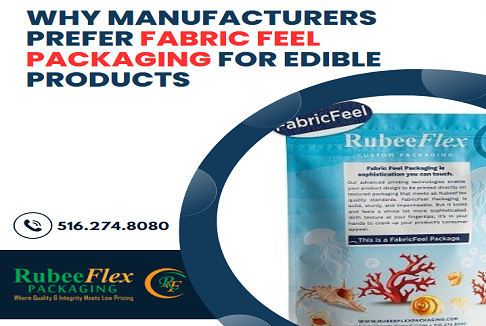Why Manufacturers Prefer Fabric Feel Packaging for Edible Products

Manufacturers prefer fabric-feel packaging for edible products for several reasons. However, it’s important to note that specific preferences can vary depending on the brand, product type, and target market. Here are some reasons why fabric-feel packaging is getting chosen for edible products:
Aesthetic Appeal: Fabric-feel packaging can convey a sense of luxury and sophistication. It often looks and feels more high-end compared to traditional plastic or paper packaging. This can be particularly advantageous for premium or gourmet edible products, such as chocolates, confectionery, or high-end teas and coffees.
Differentiation: In a competitive market, unique packaging can help a product stand out. Fabric-feel packaging can provide a distinctive and memorable appearance that helps consumers recognize the product on the shelf.
Tactile Experience: The texture of fabric-feel packaging can enhance the consumer’s tactile experience, making the product more engaging. This sensory experience can help establish a stronger emotional connection with the product.
Perceived Quality: Consumers often associate fabric-feel packaging with higher quality. Even if the actual product quality is the same, premium packaging can lead consumers to perceive the contents as being of higher quality.
Environmental Considerations: Some fabric-feel materials may be more eco-friendly than traditional packaging materials, such as single-use plastics. Manufacturers looking to appeal to environmentally conscious consumers may opt for sustainable, fabric-like materials.
Brand Image: Using fabric-feel packaging can align with a brand’s image and values. If a brand wants to project an image of elegance, sustainability, or craftsmanship, fabric-feel packaging can help reinforce that message.
Versatility: Fabric-feel packaging can be used for a variety of edible products, including chocolates, confectionery, nuts, teas, and more. It is adaptable to different product types and sizes.
Product Protection: Depending on the specific fabric-feel material used, it can offer good protection for the edible product. For example, some fabric-feel materials may have barrier properties that help keep the product fresh and extend its shelf life.
Customization: Fabric-feel materials can often be customized more easily than traditional materials. Manufacturers can choose from a wide range of colors, patterns, and finishes to create packaging that fits their brand and product identity.
Durability: Some fabric-feel materials are quite durable, offering good protection for the product inside. This is important for edible products that may be fragile or perishable.
Consumer Preference: Market research and consumer surveys may indicate that consumers prefer fabric-feel packaging for certain types of edible products. Manufacturers often strive to cater to consumer preferences.
Market Trends: Packaging trends are constantly evolving, and fabric-feel materials may be in vogue at a given time. Manufacturers often adapt to these trends to stay competitive and meet consumer expectations.
Conclusion
It’s worth noting that the choice of packaging material should align with the specific needs and characteristics of the edible product and the target market. While fabric-feel packaging can offer several advantages, it may not be suitable for all types of food products.
Additionally, it may come with higher production costs compared to more traditional packaging materials, so manufacturers must weigh these factors carefully in their decision-making process. They may contact RubeeFlex Packaging for the latest materials and designs, with certification from the Food Safety Department. Rubeeflex Packaging is known for flexible packaging and offers the latest designs and customized solutions for each company’s market needs.